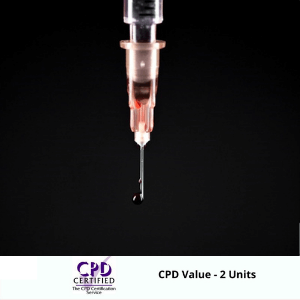Sharps Awareness
The Health and Safety (Sharp Instruments in Healthcare) Regulations 2013 is the piece of UK legislation that covers the safe handling and disposal of sharps for healthcare professionals and contractors. The regulation requires that health professionals carry out a post-implementation review, to test the effectiveness of the sharps regulatory process. This is more commonly known as PIR and should be carried out periodically after it has been implemented and operational
While sharps primarily concern health professionals, there is a common misconception that sharps injury awareness are of no concern to those in other industries. However, it is often quite common for people in other industries such as waste disposal to come into contact with used sharps.
Course Content
In this course we start by looking at some statistics relating to discarded needles and hence define the term ‘sharps’. We then look at the different classifications of ‘sharps litter’, ranging from needles, syringes and scalpel blades to broken glass, knives, scissors and nails.
The course covers the primary and secondary risks from sharps. It looks at the responsibilities of employers and how they must use risk assessment to ensure workers remain safe from sharps. Then, the course takes a detailed look at Hepatitis B, Hepatitis C, HIV and Tetanus. This is followed by information on the chain of infection. Candidates will learn how infections spread and the steps to take to break the chain and stop the process.
Handling and Reporting
The course discusses the likelihood of picking up an infection as a result of contact with a needlestick and the factors that can affect this. It is crucial to handle all discarded sharps safely so the course illustrates all areas of safe handling and disposal of sharps. This includes equipment such as litter pickers, forceps, disinfectant sprays and gloves. It also discusses the correct techniques you should employ to avoid injury. The course highlights handling procedures, including how to dispose of discarded sharps safely and how to remove disposable gloves to minimise cross-contamination.
Finally, we cover how to report discarded sharps and the correct procedures to follow if you’re unlucky enough to receive a sharps injury. Under RIDDOR, you must report sharps injuries if any of the following apply:
- an employee is injured by a sharp known to be contaminated with a blood-borne virus (BBV)
- the employee receives a sharps injury and a BBV acquired by this route seroconverts. This is reportable as a disease;
- if the injury itself is so severe that it must be reported.
| Course Content | Module |
| Sharp safety, the basics | 1 |
| Needlestick injuries | 2 |
| The chain of infection | 3 |
| Chances of infection | 4 |
| Equipment | 5 |
| Safe handling procedures | 6 |
Course Assessment
Online assessment for this sharps awareness training is carried out by a series of multiple choice questions. Candidates must answer 70% of the questions correctly to pass each module. We advise you to complete each module and answer the question before moving on to the next module. This provides a better learning experience because you will need to have knowledge from earlier modules to understand some of the material in the later modules. For those who complete the course successfully, a PDF certificate of the award is sent directly to your inbox. Hard copies of the award are available on request. The course takes 55 minutes of training to complete. This is course content only and does not cover the time it takes to answer questions.
Related courses to Sharps Awareness, safe handling and disposal of sharps, include
Infection Control
Emergency First Aid – Annual Refresher Course



